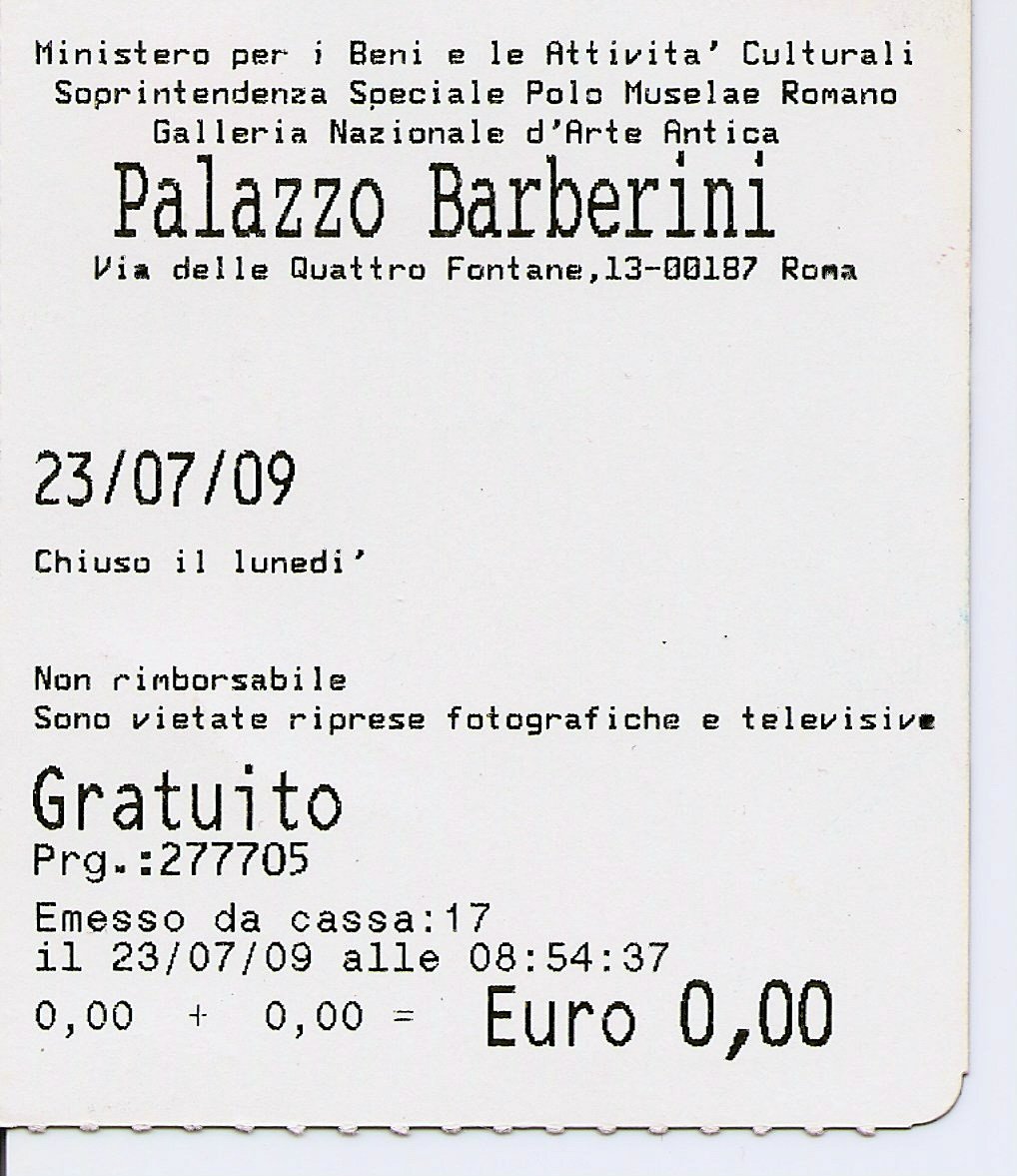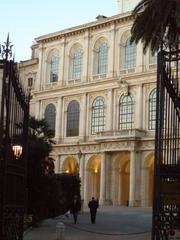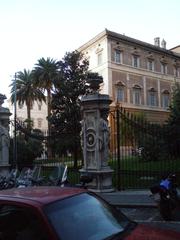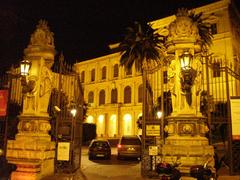
Palazzo Barberini Rome: Complete Guide to Visiting Hours, Tickets, and Historical Significance
Date: 14/06/2025
Introduction
Palazzo Barberini is a crown jewel of Baroque Rome, celebrated for its monumental architecture, world-class art collections, and pivotal role in the city’s cultural evolution. Commissioned in 1625 by Pope Urban VIII for the Barberini family, the palace is a collaborative masterpiece by three Baroque luminaries—Carlo Maderno, Gian Lorenzo Bernini, and Francesco Borromini. Today, it houses the Gallerie Nazionali di Arte Antica, presenting iconic works by Caravaggio, Raphael, Pietro da Cortona, and others. This guide provides comprehensive information on Palazzo Barberini visiting hours, ticketing, accessibility, and what to expect, ensuring an enriching experience for every visitor (palazzo-barberini.com; palazzobarberinirome.com; itinerarinellarte.it).
Table of Contents
- Introduction
- History and Construction
- Architectural Highlights
- Evolution and Cultural Significance
- National Gallery of Ancient Art
- Major Exhibitions: “Caravaggio 2025”
- Gardens and Outdoor Spaces
- Visitor Information: Hours, Tickets, Accessibility
- Frequently Asked Questions (FAQ)
- Nearby Attractions
- Travel Tips
- Conclusion
- References
History and Construction
Palazzo Barberini embodies the ambitions of the Barberini family and the grandeur of 17th-century papal Rome. Built on the site of the former Villa Sforza, construction began in 1625 under Carlo Maderno, who established the palace’s signature “H” layout. After Maderno’s death, Gian Lorenzo Bernini and Francesco Borromini advanced the project, integrating dramatic staircases and innovative spatial solutions.
The palace was designed not merely as a family residence but as a powerful architectural statement. Its vast façade, central courtyard, and opulent interiors showcased the Barberini family’s wealth, taste, and influence within Rome’s elite (palazzo-barberini.com).
Architectural Highlights
Façade and Layout
Palazzo Barberini’s expansive façade—over 80 meters long—combines classical and Baroque elements, crowned with an ornate balustrade and punctuated by large windows, maximizing light and grandeur (palazzo-barberini.com). The palace’s “H”-shaped plan features two parallel wings joined by a central hall, a pioneering design in Baroque architecture (palazzobarberini.info).
Grand Staircases
- Bernini’s Scalone d’Onore: This monumental staircase is a theatrical ascent, reflecting Bernini’s flair for awe-inspiring spaces.
- Borromini’s Helical Staircase: An oval, spiraling marvel supported by Doric columns and illuminated by an oculus. The staircase exemplifies Baroque ingenuity and the rivalry between Rome’s greatest architects (througheternity.com).
Interior Decoration
The palace interiors are lavishly decorated with frescoes, stuccoes, and period furnishings. The ceiling of the Grand Salon is adorned with Pietro da Cortona’s “The Triumph of Divine Providence” (1632–1639), a dynamic allegory glorifying the Barberini legacy (palazzo-barberini.com).
Evolution and Cultural Significance
Initially a symbol of papal power, Palazzo Barberini evolved into a vibrant center for politics, society, and the arts. It hosted dignitaries, artists, and intellectuals, reinforcing the Barberini family’s cultural influence. Following the family’s decline, the palace saw various uses—including military and government offices—before its acquisition by the Italian State in 1949. It is now the seat of the Gallerie Nazionali di Arte Antica, preserving and showcasing an unparalleled collection of art (palazzo-barberini.com).
National Gallery of Ancient Art
Palazzo Barberini is home to the National Gallery of Ancient Art, one of Italy’s premier collections of Renaissance and Baroque paintings. Highlights include:
- Caravaggio: “Judith Beheading Holofernes,” “Saint Francis in Meditation,” and pieces featured in the “Caravaggio 2025” exhibition.
- Raphael: “La Fornarina,” an enigmatic portrait celebrated for its beauty and subtle symbolism.
- Pietro da Cortona: The grand ceiling fresco, “The Triumph of Divine Providence.”
- Other Masters: Works by Titian, Holbein, El Greco, Poussin, Guido Reni, and more (palazzo-barberini.com; palazzobarberinirome.com).
Artworks are displayed in opulent rooms that evoke the historical context of their creation and collection, offering an immersive viewing experience (palazzo-barberini.com).
Major Exhibitions: “Caravaggio 2025”
The landmark “Caravaggio 2025” exhibition (March 7 – July 6, 2025) gathers 24 autograph works—including rare loans and recent rediscoveries—from leading museums and private collections worldwide (itinerarinellarte.it; art-insider.com). Curated into four thematic sections, the exhibition traces Caravaggio’s evolution from his early years in Rome to his mature works in Naples.
Key highlights include:
- “Judith and Holofernes”
- “Narcissus”
- “Ecce Homo” (on loan from Museo Nacional del Prado)
- “Portrait of Maffeo Barberini”
- “Jupiter, Neptune, and Pluto”—Caravaggio’s only known mural, on view for this occasion
The exhibition underscores Palazzo Barberini’s commitment to scholarship and public engagement, and cements its place as a dynamic hub for art lovers and researchers (art-insider.com; palazzobarberinirome.com).
Gardens and Outdoor Spaces
The two-hectare gardens, originally designed by Carlo Maderno, offer a tranquil retreat. Visitors can admire Baroque fountains, classical statues (including a Borghese Gladiator replica), and rare trees. Garden enhancements in the 19th and 20th centuries—including a greenhouse and English-style landscaping—add further layers to the site’s history (palazzobarberinirome.com).
Visitor Information: Hours, Tickets, Accessibility
Opening Hours
- Tuesday–Sunday: 8:30 AM – 7:00 PM (last admission at 6:00 PM)
- Closed: Mondays and select holidays
(palazzobarberini.info)
Tickets
- Standard Admission: €15 (includes Galleria Corsini within 20 days)
- Reduced Admission: €2 for EU citizens aged 18–25
- Special Exhibitions: Separate pricing may apply (e.g., €18 for “Caravaggio 2025”)
- Roma Pass & Omnia Card: Free or discounted entry
- Booking: Reservation required on weekends and holidays; online booking recommended (barberinicorsini.org; palazzobarberinirome.com)
Accessibility
- Wheelchair access via ramps and elevators to all floors
- Reserved parking for visitors with disabilities
- Accessible restrooms and seating areas
- Staff assistance available (cuddlynest.com)
Visitor Services
- Cloakroom for small bags; large luggage not permitted
- Group tours limited to 25 people; radio transmitters required for guided groups
- Multilingual audio guides and guided tours available
- No on-site café, but nearby dining options abound (romeactually.com)
Frequently Asked Questions (FAQ)
Q: What are the best times to visit?
A: Early mornings on weekdays are ideal for avoiding crowds.
Q: Are photography and videography allowed?
A: Non-flash photography is generally permitted except during temporary exhibitions.
Q: Is the palace wheelchair accessible?
A: Yes, with ramps, elevators, and accessible facilities.
Q: How do I get to Palazzo Barberini?
A: Metro Line A (Barberini stop) and several bus lines serve the area.
Q: Are guided tours available?
A: Yes, in multiple languages; advance booking is recommended.
Nearby Attractions
Palazzo Barberini’s central location makes it an excellent base for exploring:
- Piazza Barberini and Triton Fountain
- Quirinal Palace
- Trevi Fountain (10-minute walk)
- Spanish Steps
- Via Veneto shopping and dining
- Palazzo Corsini (included with combined ticket)
(mamalovesrome.com; cuddlynest.com)
Travel Tips
- Book tickets online to avoid queues, especially during peak seasons and special exhibitions.
- Allow 2–3 hours for a thorough visit, including the gardens and, if available, the Mithraeum (ancient temple, open select Saturdays with separate ticket) (thegeographicalcure.com).
- Spot the Barberini bees—a recurring motif in the palace’s architecture and decoration.
- End your visit via Borromini’s staircase for a memorable Baroque experience.
Conclusion
Palazzo Barberini is a must-visit destination for anyone interested in Rome’s artistic, architectural, and cultural heritage. From Baroque masterpieces and innovative architecture to tranquil gardens and groundbreaking exhibitions like “Caravaggio 2025,” the palace offers a rich and immersive journey into the heart of Rome. For up-to-date visiting hours, ticketing, and exhibition details, consult the official website.
Enhance your experience with guided tours or the Audiala app, and explore related articles for more insights into Rome’s historical treasures. Plan your visit today and step into a world where art, history, and architecture converge.




















































































































































































































































